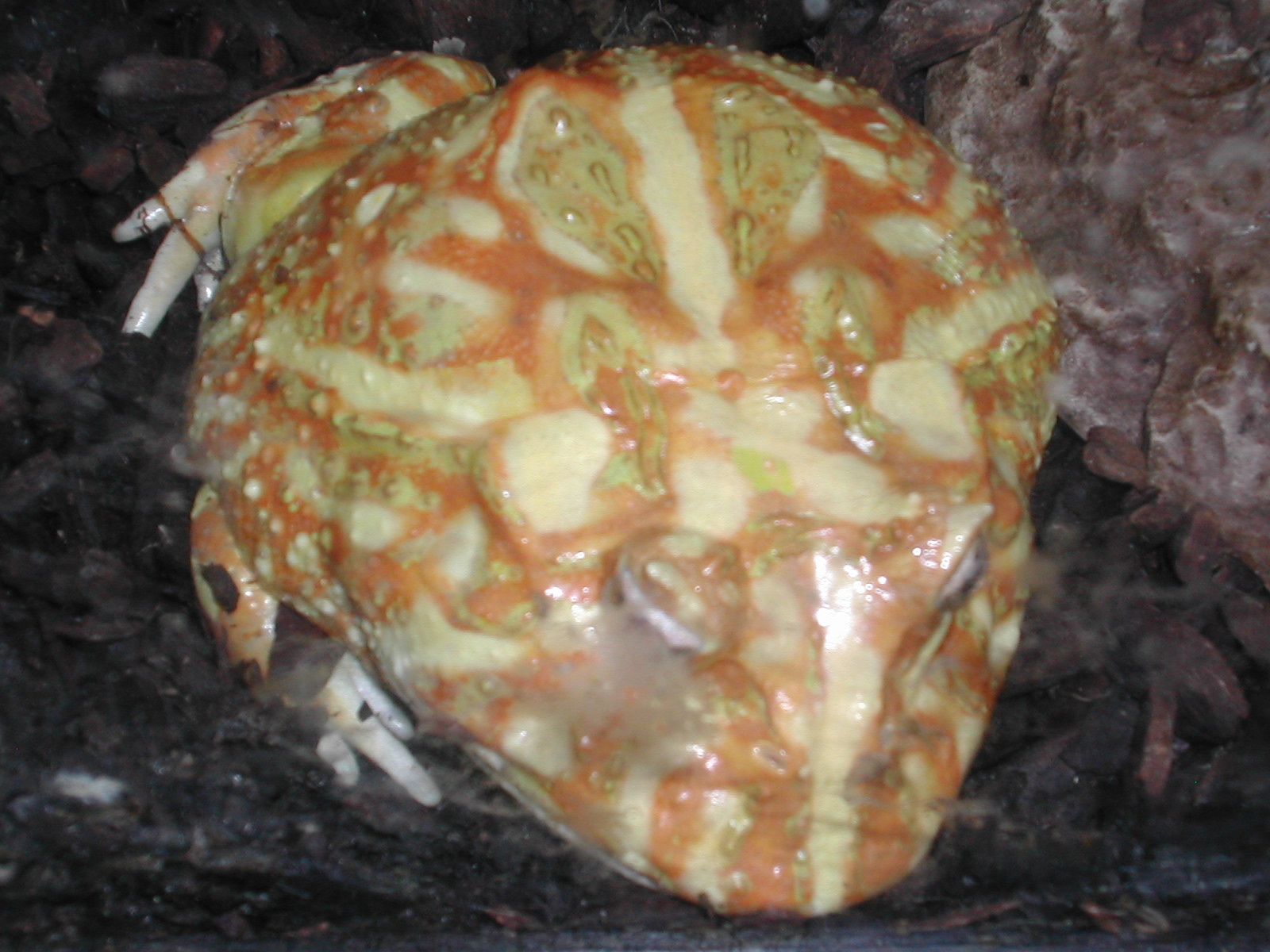|
Care of your
Argentine Horned and Pixie Frogs

General-
Argentine Horned frogs and the "pixie" (or African Bullfrogs) are large, terrestrial amphibians that may be the perfect choice if you are looking for a fascinating creature for your terrarium. These frogs grow quickly to a large size, so be prepared to feed your eating machine, and be aware that they can and will bite if given the opportunity. Captive bred babies are readily available and several color phases exist for each species as well. The young frogs are very hardy and
easy to care for. They do
quite well on a diet of crickets
of an appropriate size (usually about 1/4 inch to 1/2 inch to start). It is
important to supply vitamins and
minerals to your growing frog.
This can be accomplished by “gut-loading”
crickets by feeding them such
items as orange slices, carrots,
salad greens, fish flake food, or
a commercially available cricket
food prior to giving them to your
frog. Additionally, the crickets
can be dusted (coated in powder)
with a quality commercial
vitamin/mineral powder just before
providing them to your frog to
eat. Young frogs should be fed
every other day or so to maintain a
healthy growth rate. It is a good
idea to vary the diet from time to
time by offering some other insect
prey such as waxworms,
butterworms, moths or roaches. Remember to keep
the prey size appropriate and use
the worms sparingly, as they are
mostly fatty or chitinous. Once thes frogs get to about an inch and a half, they will begin to accept pre-killed pinkie mice dangled from tongs in front of their face. As these frogs are a "sit-and-wait" predator, they often wait for food to walk right in front of them before they eat it. Keep these frogs in a warm, humid terrarium or alternatively, keep them in a smaller sized container on moist paper towels or a soil substrate and change the substrate often to prevent the build up of ammonia and other toxins. Too much water can result in your frog drowning, so do not keep your frog in an aquatic environment.
Adults- The adults are
maintained in much the same way.
Using a larger prey item feedings
can be scaled back to two to three
times a week. They don’t need
vitamin supplementation quite as
often either, maybe with every
other to every third feeding. You
can offer adult frogs an
occasional mouse to vary
the diet and supply a more
complete diet, but do not maintain these frogs solely on mice. Too fatty a diet will cause fat deposits to form (often on the frogs eyes) and eventually lead to death.
General-
The Horned frogs come from the
South America and the pixie frogs come from Africa. They are
active during the daytime hours. A 10-gallon
tank will comfortably house an
adult Horned frog, the African Bullfrog will require more space. A horzontal orientation to the tank will be more appropriate here, as these frogs will not climb. I recommend a smaller enclosure (such as a kritter keeper) for juveniles only because it makes
it easier for them to capture prey
in the smaller area and proper humidity levels may be easier for you to maintain. Paper towels
make cleaning quick
and easy and eliminates the
possibility of ingesting any substrate material
that may impede
digestion and kill or injure the frog. The
adults, however, can be kept on a
soil substrate
without problems. Add some rocks,
branches, and hardy, sturdy plants to make
an interesting landscape for your
frog to explore. It is important to keep the water and substrate clean to prevent toxic levels of ammonia buildup or outbreaks of "red leg", a bacterial infection in the bloodstream. Lighting is a matter
of personal choice since the
frogs don’t seem to care too much. I recommend coil bulbs or other flourescent lighting because they light a tank sufficiently for live plants without a lot of heat build up that would kill the frog.
Other Helpful Info:
̃
Always buy a healthy captive
bred animal and learn as much as
you can from the source that you
are buying it from, such as age,
sex, what is it eating, etc.
̃
Find a local veterinarian who is
knowledgeable about reptiles and amphibians before
any problems arise!
̃
Buy a good book about Horned Frogsor at least a book with a
decent section about these
animals and keep it on hand for
reference. This care sheet
contains only initial
information to get you started
and is by no means complete.
̃
Enjoy your Horned Frog! These
are fantastic and rewarding
pets.
|